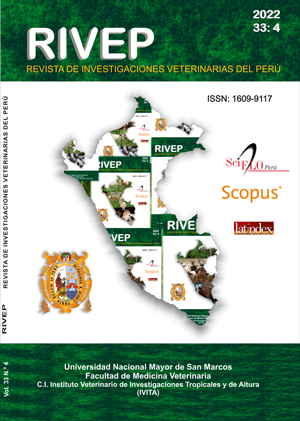Ecographic biometry of the ocular globe in working horses (Equus ferus caballus) of the province of Córdoba, Colombia
DOI:
https://doi.org/10.15381/rivep.v33i4.20892Keywords:
ultrasound, equine, eye evaluation, biometryAbstract
The B-mode ultrasound technique offers the possibility of performing an ocular biometric evaluation of the horse. In Colombia there are no reports on ocular biometric measurements in horses, so the objective of this article was to report the ultrasound appearance of the normal eye and obtain biometric values that can serve as a basis for ocular evaluation. A descriptive study was conducted in the eyes of 50 working horses from the department of Córdoba. The anterior chamber (AC), lens length (Ll), lens width (Lw), vitreous chamber (VC) and axial globe length (AGL) were measured by ultrasound. The sample consisted mainly of Colombian Creole horses (60%) and Appaloosa (32%), 58% were males, average age of 6.7±4.9 years. The biometric values obtained corresponded to AC: 0.68±0.08 cm; Ll: 1.11±0.09 cm, Lw: 2.00±0.16 cm; VC: 1.80±0.15 cm, and AGL: 3.91±0.28 cm. Sex differences were observed for Lw and AGL.
Downloads
Downloads
Published
Issue
Section
License
Copyright (c) 2022 Jhonny Alberto Buitrago Mejia, Nathalia Maria Del Pilar Correa Valencia, Jose Alberto Cardona Álvarez

This work is licensed under a Creative Commons Attribution 4.0 International License.
AUTHORS RETAIN THEIR RIGHTS:
a. Authors retain their trade mark rights and patent, and also on any process or procedure described in the article.
b. Authors retain their right to share, copy, distribute, perform and publicly communicate their article (eg, to place their article in an institutional repository or publish it in a book), with an acknowledgment of its initial publication in the Revista de Investigaciones Veterinarias del Perú (RIVEP).
c. Authors retain theirs right to make a subsequent publication of their work, to use the article or any part thereof (eg a compilation of his papers, lecture notes, thesis, or a book), always indicating the source of publication (the originator of the work, journal, volume, number and date).



